Potential Toxic Elements Pollution Status in Zones of Technogenic Impact in Central Regions of Perú
Abstract
:1. Introduction
2. Materials and Methods
2.1. Study Area
2.2. Soil Analysis
2.3. Soil Data Analysis
2.4. Spatial Distribution
2.5. Threshold Values
2.6. Environmental Indices
2.7. Environmental Indices with Peruvian Environmental Quality Standards (EQS) for Soil
2.8. Health Risks
2.8.1. Non-Carcinogenic Risk
2.8.2. Carcinogenic Risk
3. Results and Discussion
3.1. Exploratory Data Analysis
3.2. Univariate Statistics
3.3. Multivariate Statistics
3.4. Threshold Values and Assessment of Potential Contamination
3.5. Assessment of Potential Contamination
3.6. Health Risks
3.7. Spatial Distribution
4. Conclusions
Supplementary Materials
Author Contributions
Funding
Data Availability Statement
Acknowledgments
Conflicts of Interest
References
- Rodríguez, N.; McLaughlin, M.; Pennock, D. La Contaminación del Suelo: Una Realidad Oculta; FAO: Roma, Italy, 2019; Available online: https://www.fao.org/3/i9183es/i9183es.pdf (accessed on 3 March 2023).
- Mahecha, J.; Trujillo, J.Y.; Torres, M. Análisis de estudios en metales pesados en zonas agrícolas de Colombia. Orinoquia 2017, 21 (Suppl. S1), 83–93. [Google Scholar] [CrossRef]
- Targulian, V.O.; Bronnikova, M.A. Soil Memory: Theoretical basics of the concept, its current state and prospects for development. Eurasian Soil Sc. 2019, 52, 229–243. [Google Scholar] [CrossRef]
- Instituto Nacional de Estadística e Informática [INEI]. Población Peruana Alcanzó las 33 Millones 396 Mil Personas en el año 2022. 2022. Available online: https://www.inei.gob.pe/media/MenuRecursivo/noticias/nota-de-prensa-no-115-2022-inei.pdf (accessed on 3 March 2023).
- Sánchez, J.; Cubas, N. Contaminación agricolaación por uso de aguas residuales. Alfa Rev. De Investig. En Cienc. Agronómicas Y Vet. 2021, 5, 65–77. [Google Scholar] [CrossRef]
- Arce, S.; Calderón, M. Suelos contaminados con plomo en la Ciudad de La Oroya-Junín y su impacto en las aguas del Río Mantaro. Rev. Del Inst. De Investig. De La Fac. De Minas Metal. Y Cienc. Geográficas 2017, 20, 48–55. Available online: https://revistasinvestigacion.unmsm.edu.pe/index.php/iigeo/article/view/14389/12724 (accessed on 3 March 2023).
- Chira, J. Dispersión geoquímica de metales pesados y su impacto en los suelos de la cuenca del río Mantaro, departamento de Junín-Perú. Rev. Del Inst. De Investig. De La Fac. De Minas Metal. Y Cienc. Geográficas 2021, 24, 47–56. [Google Scholar] [CrossRef]
- Santos, F.; Martinez, A.; Alonso, P.; García, A. Geochemical Background and Baseline Values Determination and Spatial Distribution of Heavy Metal Pollution in Soils of the Andes Mountain Range (Cajamarca-Huancavelica, Peru). Int. J. Environ. Res. Public Health 2017, 14, 859. [Google Scholar] [CrossRef]
- Soto, M.; Rodriguez, L.; Olivera, M.; Arostegui, V.; Colina, C.; Garate, J. Riesgos para la salud por metales pesados en productos agrícolas cultivados en áreas abandonadas por la minería aurífera en la Amazonía peruana. Sci. Agropecu. 2020, 11, 49–59. [Google Scholar] [CrossRef]
- Ley Nº 28611, Ley General del Ambiente. 10 April 2005. Available online: https://www.minam.gob.pe/wp-content/uploads/2017/04/Ley-N°-28611.pdf (accessed on 15 May 2023).
- USEPA. METHOD 3050B-Microwave Assisted Acid Digestion of Sediments, Sludges, Soils and Oils; United States Environmental Protection Agency: Washington, DC, USA, 1996.
- USEPA. METHOD 6020B-Inductively Coupled Plasma Mass Spectrometry; United States Environmental Protection Agency: Washington, DC, USA, 2014.
- Bohemen, H.V.; Janssen Van De Laak, W.H. The influence of road infrastructure and traffic on soil, water, and air quality. Environ. Manag. 2003, 31, 0050–0068. [Google Scholar] [CrossRef]
- Szwalec, A.; Mundała, P.; Kędzior, R.; Pawlik, J. Monitoring and assessment of cadmium, lead, zinc and copper concentrations in arable roadside soils in terms of different traffic conditions. Env. Monit Assess 2020, 192, 155. [Google Scholar] [CrossRef]
- Consorcio Transmantaro, S.A. Estudio de Impacto Ambiental Detallado para el Proyecto “Enlace 500 kV Nueva Yanango—Nueva Huánuco y Subestaciones Asociadas”. 2019. Available online: https://eva.senace.gob.pe:8443/consultaCiudadano/#/ (accessed on 28 May 2023).
- Steinmüller, K. Cuadrángulo de la Unión Hoja 20j. Evaluación de Recursos Minerales (Parte de Gabinete). Informe Técnico A6417. INGEMMET: Lima, Peru, 1996. Available online: https://hdl.handle.net/20.500.12544/3938 (accessed on 19 July 2023).
- Cobbing, E.J.; Quispesivana Quispe, L.Y.; Paz Maidana, M. Geología de los cuadrángulos de Ambo, Cerro de Pasco y Ondores. Boletín, Serie A: Carta Geológica Nacional, n° 77. INGEMMET: Lima, Peru, 1996. Available online: https://hdl.handle.net/20.500.12544/200 (accessed on 19 July 2023).
- De La Cruz, J.; Valencia, M.; Boulaugger, E. Geología de los cuadrángulos de Aguaytía, Panao y Pozuzo. Boletín, Serie A: Carta Geológica Nacional, n° 80. INGEMMET: Lima, Peru, 1996. Available online: https://hdl.handle.net/20.500.12544/36 (accessed on 19 July 2023).
- León, W.; Monge, R.; Chacón, N. Geología de los cuadrángulos de Chuchurras, Ulcumayo, Oxapampa y La Merced. Boletín, Serie A: Carta Geológica Nacional, n° 78. INGEMMET: Lima, Peru, 1996. Available online: https://hdl.handle.net/20.500.12544/201 (accessed on 19 July 2023).
- Martínez, W.; Valdivia, E.; Cuyubamba, V. Geología de los cuadrángulos de Aucayacu, Río Santa Ana y Tingo María. Boletín, Serie A: Carta Geológica Nacional, n° 112. INGEMMET: Lima, Peru, 1998. Available online: https://hdl.handle.net/20.500.12544/71 (accessed on 19 July 2023).
- Quispesivana, L. Geología del cuadrángulo de Huánuco. Boletín, Serie A: Carta Geológica Nacional, n° 75. INGEMMET: Lima, Peru, 1996. Available online: https://hdl.handle.net/20.500.12544/198 (accessed on 19 July 2023).
- Fukue, M.; Yanai, M.; Sato, Y.; Fujikawa, T.; Furukawa, Y.; Tani, S. Background values for evaluation of heavy metal contamination in sediments. J. Hazard. Mater. 2006, 136, 111–119. [Google Scholar] [CrossRef] [PubMed]
- Reimann, C.; Filzmoser, P.; Garrett, R.G. Background and threshold: Critical comparison of methods of determination. Sci. Total Environ. 2005, 346, 1–16. [Google Scholar] [CrossRef] [PubMed]
- Jarva, J.; Tarvainen, T.; Reinikainen, J.; Eklund, M. TAPIR-Finnish national geochemical baseline database. Sci. Total Environ. 2010, 408, 4385–4395. [Google Scholar] [CrossRef] [PubMed]
- Maurelia, J.; Cornejo, O.; Tume, P.; Roca, N. Distribution of Heavy Metals in the Commune of Coronel, Chile. Minerals 2022, 12, 320. [Google Scholar] [CrossRef]
- Ander, E.; Johnson, C.; Cave, M.; Palumbo, B.; Nathanail, C.; Lark, R. Methodology for the determination of normal background concentrations of contaminants in English soil. Sci. Total Environ. Vol. 2013, 454–455, 604–618. [Google Scholar] [CrossRef]
- Tume, P.; Roca, N.; Rubio, R.; King, R.; Bech, J. An assessment of the potentially hazardous element contamination in urban soils of Arica, Chile. J. Geochem. Explor. 2018, 184, 345–357. [Google Scholar] [CrossRef]
- Hakanson, L. An ecological risk index for aquatic pollution-control—A sedimentological approach. Water Res. 1980, 14, 975–1001. [Google Scholar] [CrossRef]
- Müller, G. Index of geoaccumulation in sediments of the Rhine River. Geo J. 1969, 2, 108–118. [Google Scholar]
- Sutherland, R.; Tolosa, C.; Tack, F.; Verloo, M. Characterization of selected element concentrations and enrichment ratios in background and anthropogenically impacted roadside areas. Arch. Environ. Contam. Toxicol. 2000, 38, 428–438. [Google Scholar] [CrossRef] [PubMed]
- Fu, C.; Guo, J.; Pan, J.; Qi, J.; Zhou, W. Potential ecological risk assessment of heavy metal pollution in sediments of the Yangtze River within the Wanzhou section, China. Biol. Trace Elem. Res. 2009, 129, 270–277. [Google Scholar] [CrossRef] [PubMed]
- Marín, J.; Rojas, J.; Polo, C. Evaluación de riesgo ecológico por elementos potencialmente tóxicos en sedimentos costeros de un estuario tropical hipereutrófico. Rev. Int. De Contam. Ambient. 2022, 38, 54504. [Google Scholar] [CrossRef]
- Tume, P.; Gonzalez, E.; King, R.W.; Monsalve, V.; Roca, N.; Bech, J. Spatial distribution of potentially harmful elements in urban soils, city of Talcahuano, Chile. J. Geochem. Explor. 2018, 184, 333–344. [Google Scholar] [CrossRef]
- Loska, K.; Wiechuła, D.; Korus, I. Metal contamination of farming soils affected by industry. Environ. Int. 2004, 30, 159–165. [Google Scholar] [CrossRef] [PubMed]
- Ministerio del Ambiente. Decreto Supremo N.º 011-2017-MINAM; Ministerio del Ambiente: Lima, Peru, 2017; 4p. Available online: https://www.minam.gob.pe/disposiciones/decreto-supremo-n-011-2017-minam/ (accessed on 19 July 2023).
- USEPA. Risk Assessment Guidance for Superfund Volume I Human Health Evaluation Manual (Part A); Office of Emergency and Remedial Response: Washington, DC, USA, 1989; pp. 1–291. Available online: https://www.epa.gov/sites/default/files/2015-09/documents/rags_a.pdf (accessed on 19 July 2023).
- USEPA. Guidelines for Exposure Assessment. Risk Assessment Forum; U.S. Environmental Protection Agency Washington: Washington, DC, USA, 1992.
- USEPA. Supplemental Guidance for Developing Soil Screening Levels for Superfund Sites; Office of Solid Waste and Emergency Response: Washington, DC, USA, 2002.
- USEPA. Risk Assessment Guidance for Superfund (RAGS); Human Health Evaluation Manual (H. US Epa, 1(540/R/99/005)); USEPA: Washington, DC, USA, 2004; Volume I, pp. 1–156.
- USEPA; Regional Screening Level (RSL) Resident Soil Table; Varouchakis, Ε.A.; Hristopulos, D.T. Comparison of stochastic and deterministic methods for mapping groundwater level spatial variability in sparsely monitored basins. Environ. Monit. Assess. 2017, 185, 1–19. [Google Scholar] [CrossRef] [PubMed]
- USEPA. Exposure Factors Handbook: 2011 Edition; National Center for Environmental Assessment Office of Research and Development U.S. Environmental Protection Agency: Washington, DC, USA, 2011; p. 20460.
- USEPA. Regional Screening Levels (RSLs): Generic Tables (November 2020); USEPA: Washington, DC, USA, 2020.
- Zheng, N.; Jingshuang, L.; Qichao, W.; Zhongzhu, L. Health risk assessment of heavy metal exposure to street dust in the zinc smelting district, Northeast of China. Sci. Total Environ. 2010, 408, 726–733. [Google Scholar] [CrossRef]
- Peña, A.; González, M.; Lobo, M. Establishing the importance of human health risk assessment for metals and metalloids in urban environments. Environ. Int. 2014, 72, 176–185. [Google Scholar] [CrossRef]
- Liu, K.; Shang, Q.; Wan, C. Sources and Health Risks of Heavy Metals in PM2.5 in a Campus in a Typical Suburb Area of Taiyuan, North China. Atmosphere 2018, 9, 46. [Google Scholar] [CrossRef]
- Frey, P.; Reed, G. The Ubiquity of Iron. ACS Chem. Biol. 2012, 7, 1477–1481. [Google Scholar] [CrossRef] [PubMed]
- Acosta, J.; Quispe, J.; Santisteban, A.; Acosta, H. Épocas Metalogenéticas y Tipos de Yacimientos Metálicos en la Margen Occidental del sur del Perú: Latitudes 14°s–18°s. En: Congreso Peruano de Geología, 14, Congreso Latinoamericano de Geología, 13, Lima, PE, 29 Setiembre–3 Octubre 2008, Resúmenes; Sociedad Geológica del Perú: Lima, Peru, 2008; 6p, Available online: https://hdl.handle.net/20.500.12544/424 (accessed on 19 July 2023).
- Agencia Para Sustancias Tóxicas y el Registro de Enfermedades [ATSDR]. Reseña Toxicológica del Arsénico (Versión Para Comentario Público) (en Inglés); Departamento de Salud y Servicios Humanos de EE. UU., Servicio de Salud Pública: Atlanta, GA, USA, 2005. Available online: https://www.atsdr.cdc.gov/es/phs/es_phs2.html (accessed on 19 July 2023).
- Romero, K.; Martínez, O. Análisis factorial exploratorio mediante el uso de las medidas de adecuación muestral kmo y esfericidad de bartlett para determinar factores principales. J. Sci. Res. (CININGEC) 2020, 5, 903–924. Available online: https://revistas.utb.edu.ec/index.php/sr/article/view/1046 (accessed on 19 July 2023).
- Sánchez, E.; Sarria, K. Papel del Suelo en la Toxicidad del Cadmio. Ph.D. Thesis, Universidad Complutense, Madrid, Spain, 2017. Available online: https://eprints.ucm.es/id/eprint/56981/1/ELENA%20SANCHEZ%20LEON.pdf (accessed on 19 July 2023).
- Machado, A.; Velázquez, H.; García, N.; García, C.; Acosta, L.; Córdova, A.; Linares, M. Metales en PM10 y su dispersión en una zona de alto tráfico vehicular. Interciencia 2007, 32, 312–317. Available online: http://ve.scielo.org/scielo.php?script=sci_arttext&pid=S0378-18442007000500006&lng=es&tlng=es (accessed on 19 July 2023).
- Carlon, C. (Ed.) Derivation Methods of SOIL Screening Values in Europe—A Review and Evaluation of National Procedures towards Harmonization; European Commission, Joint Research Centre: Ispra, Italy, 2007. [Google Scholar]
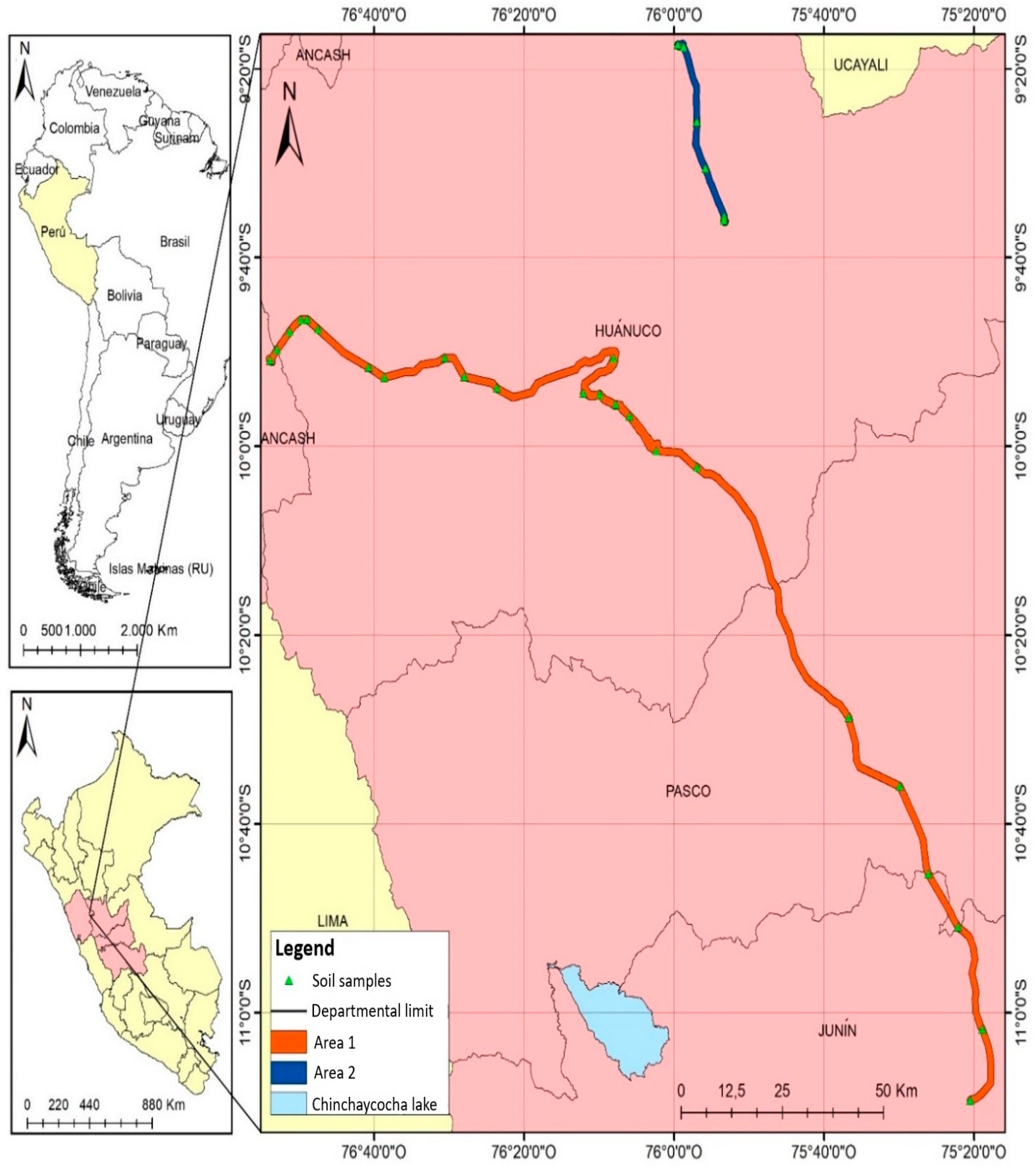
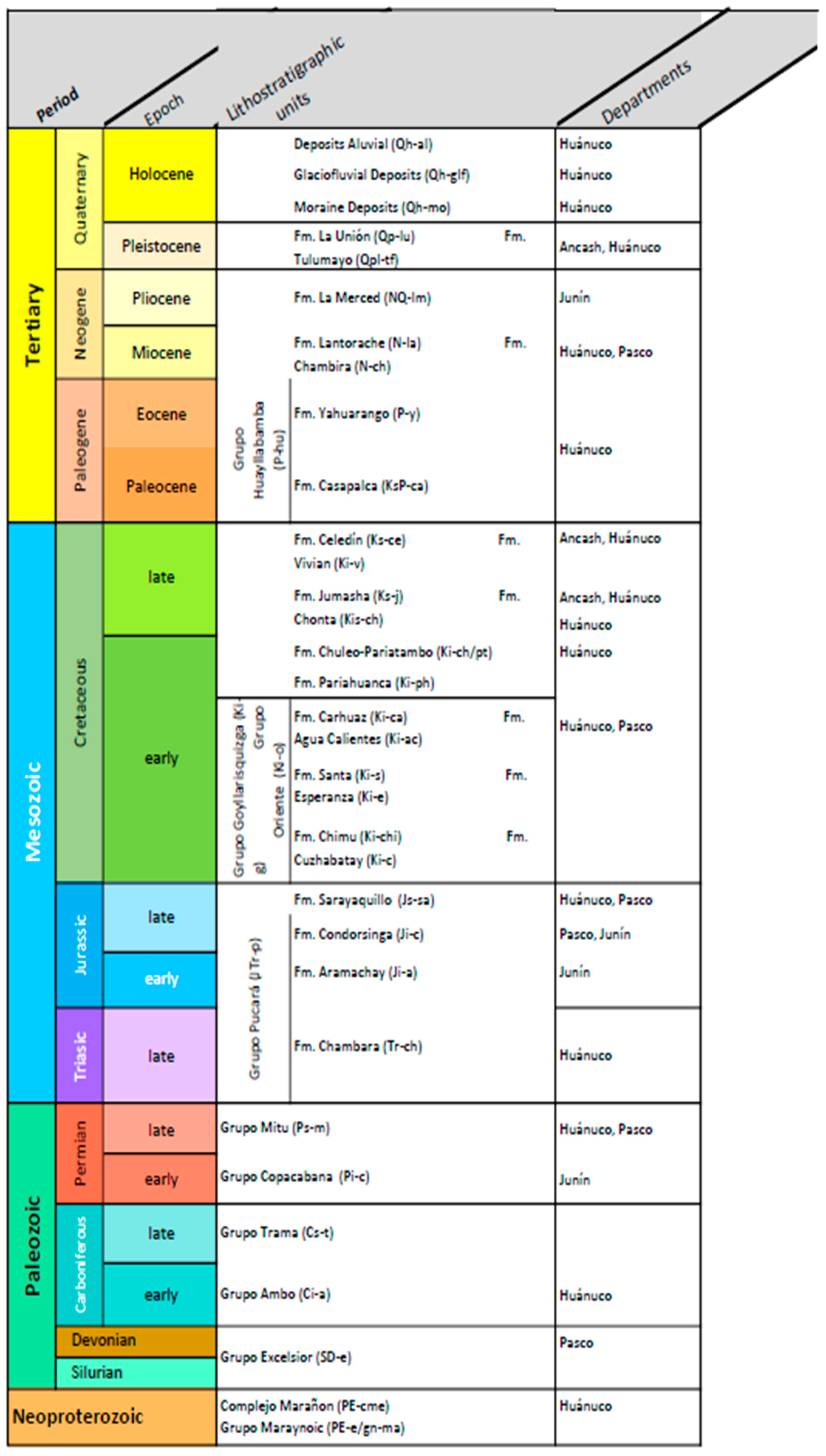

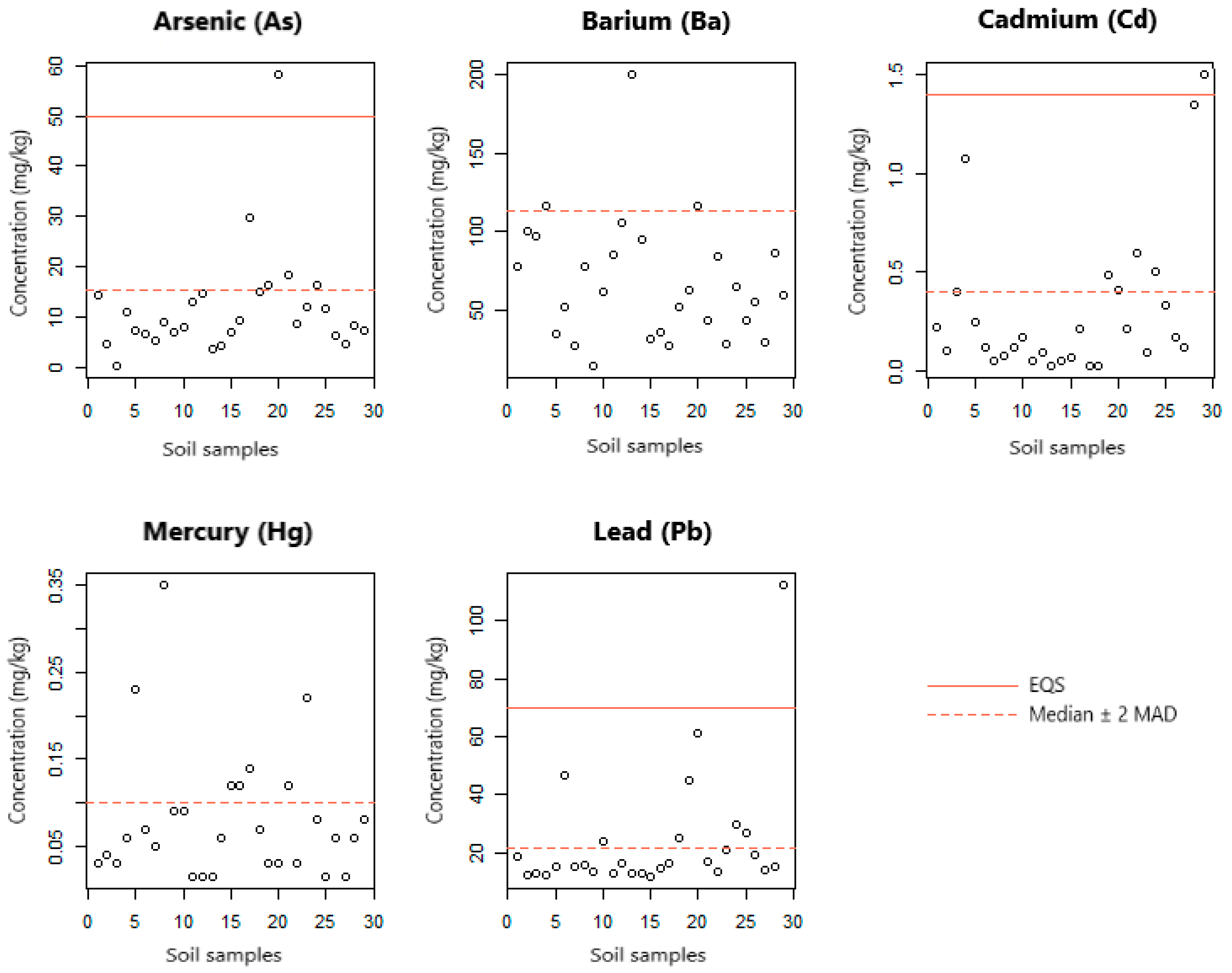
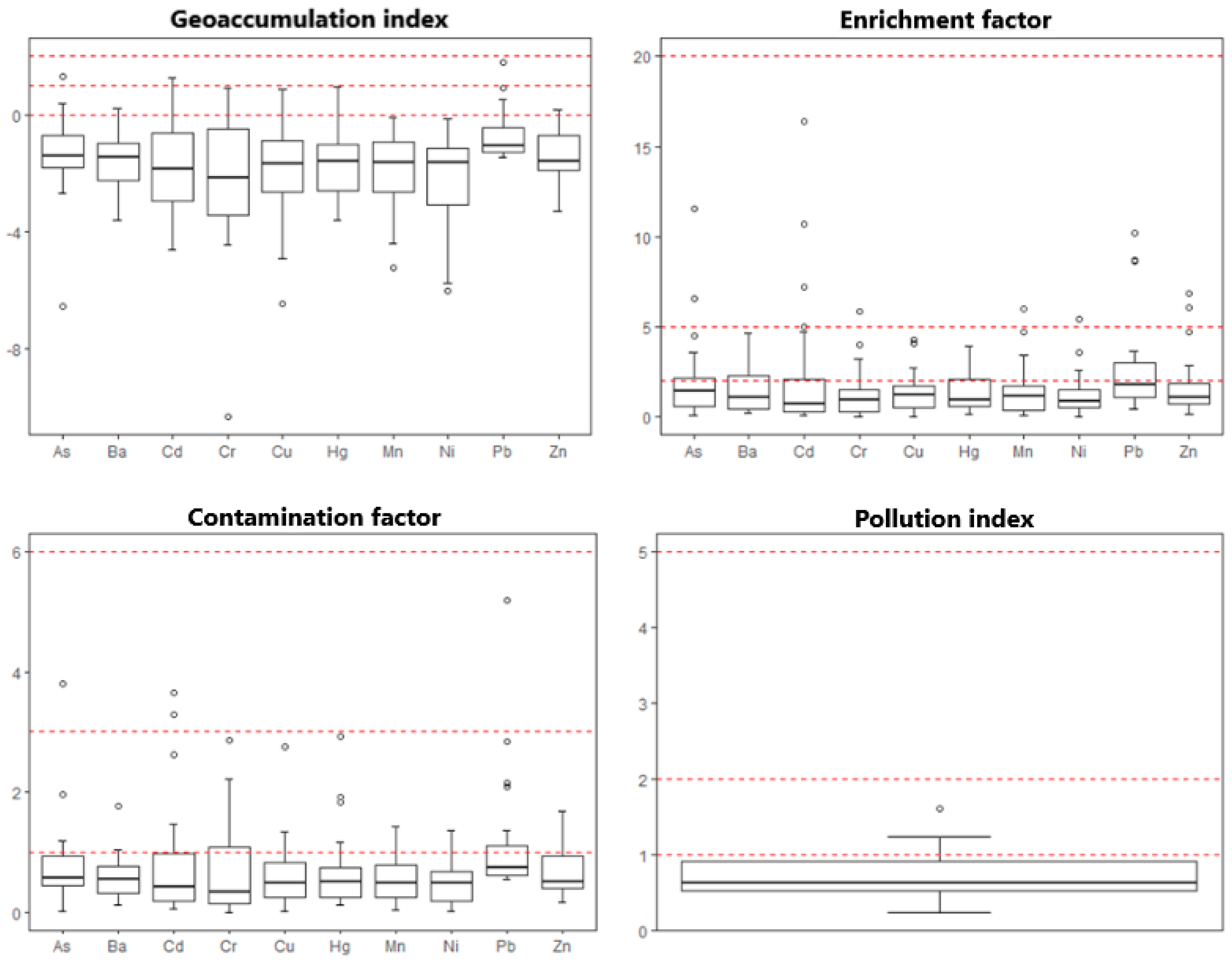
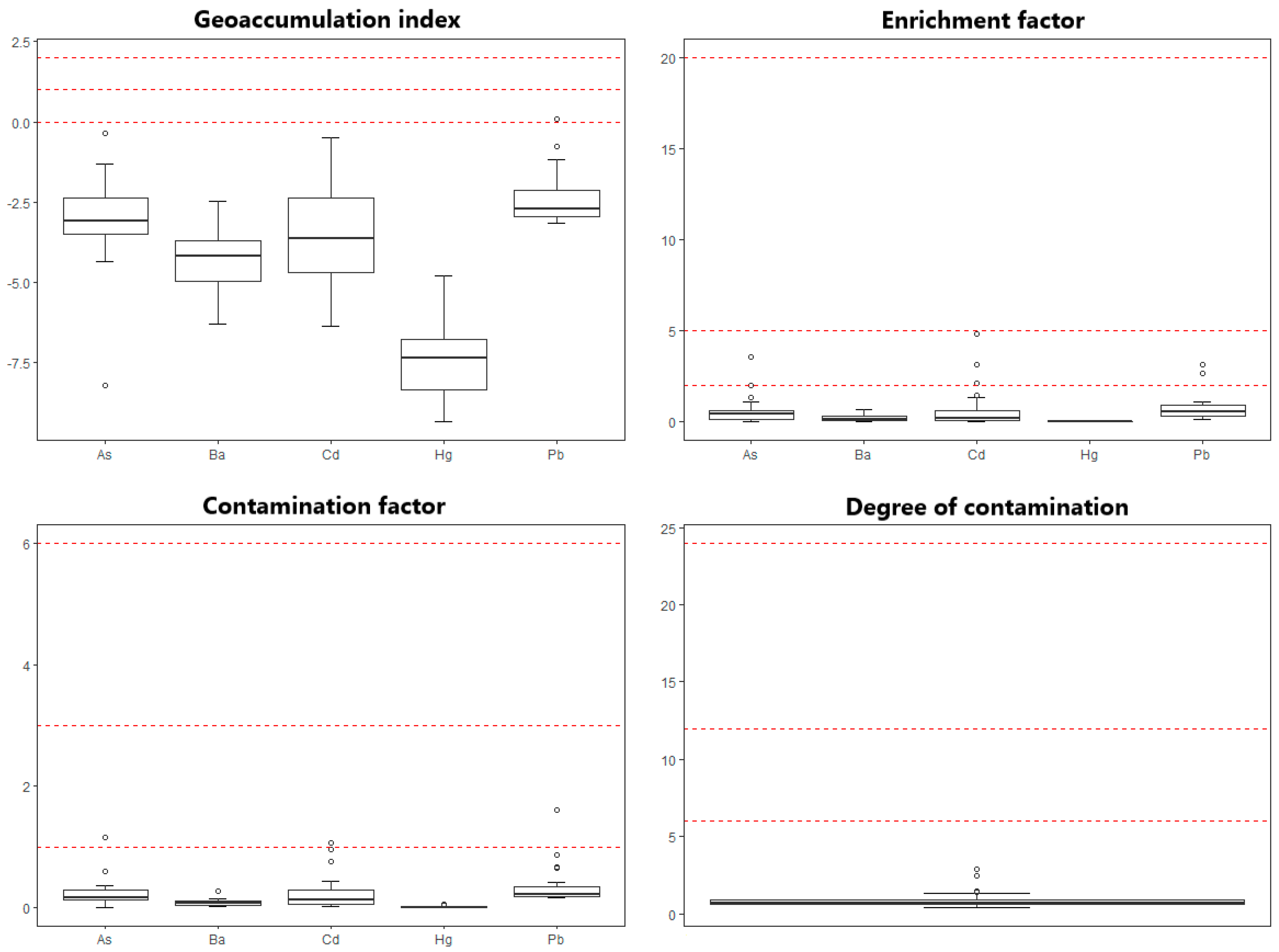

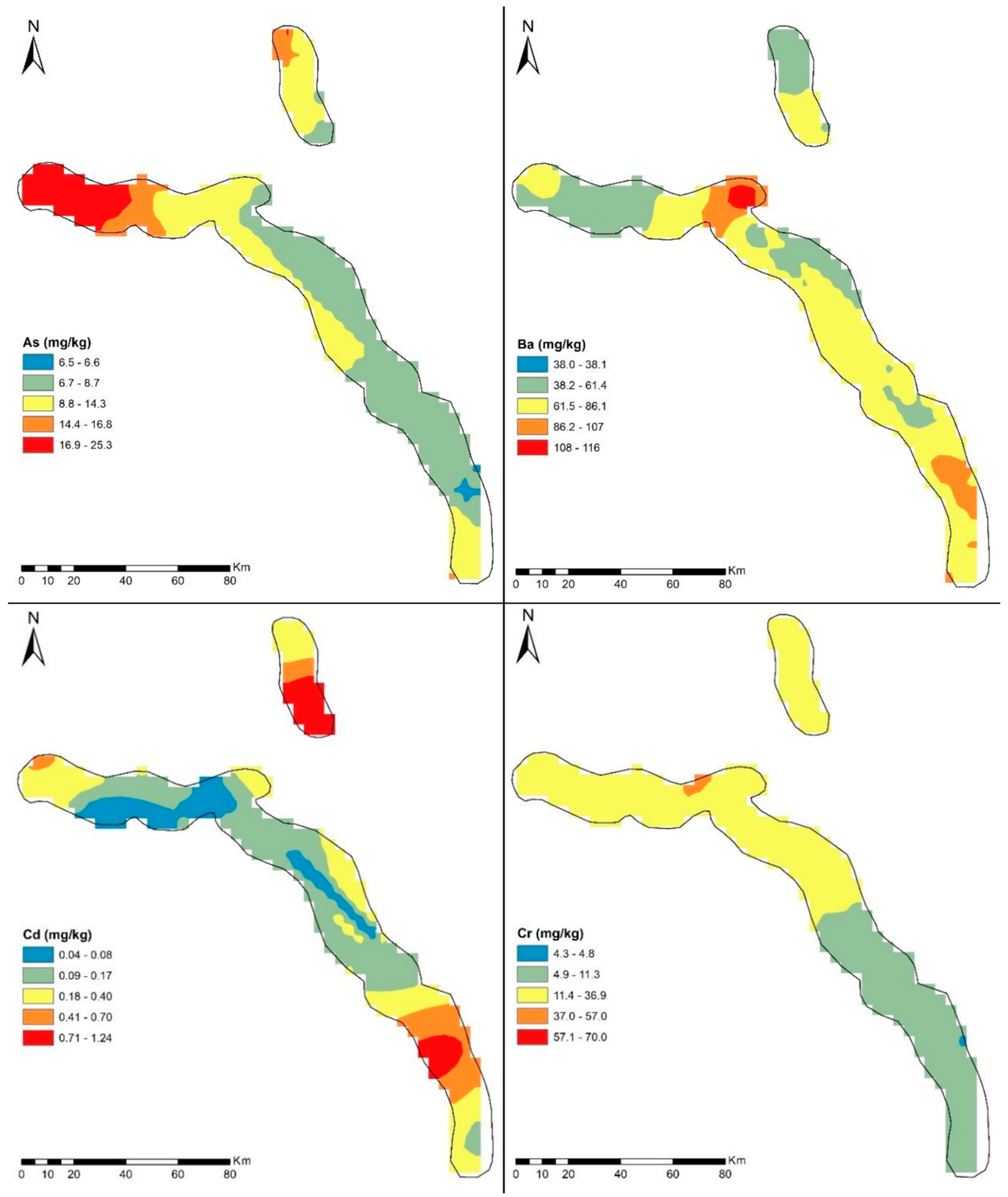
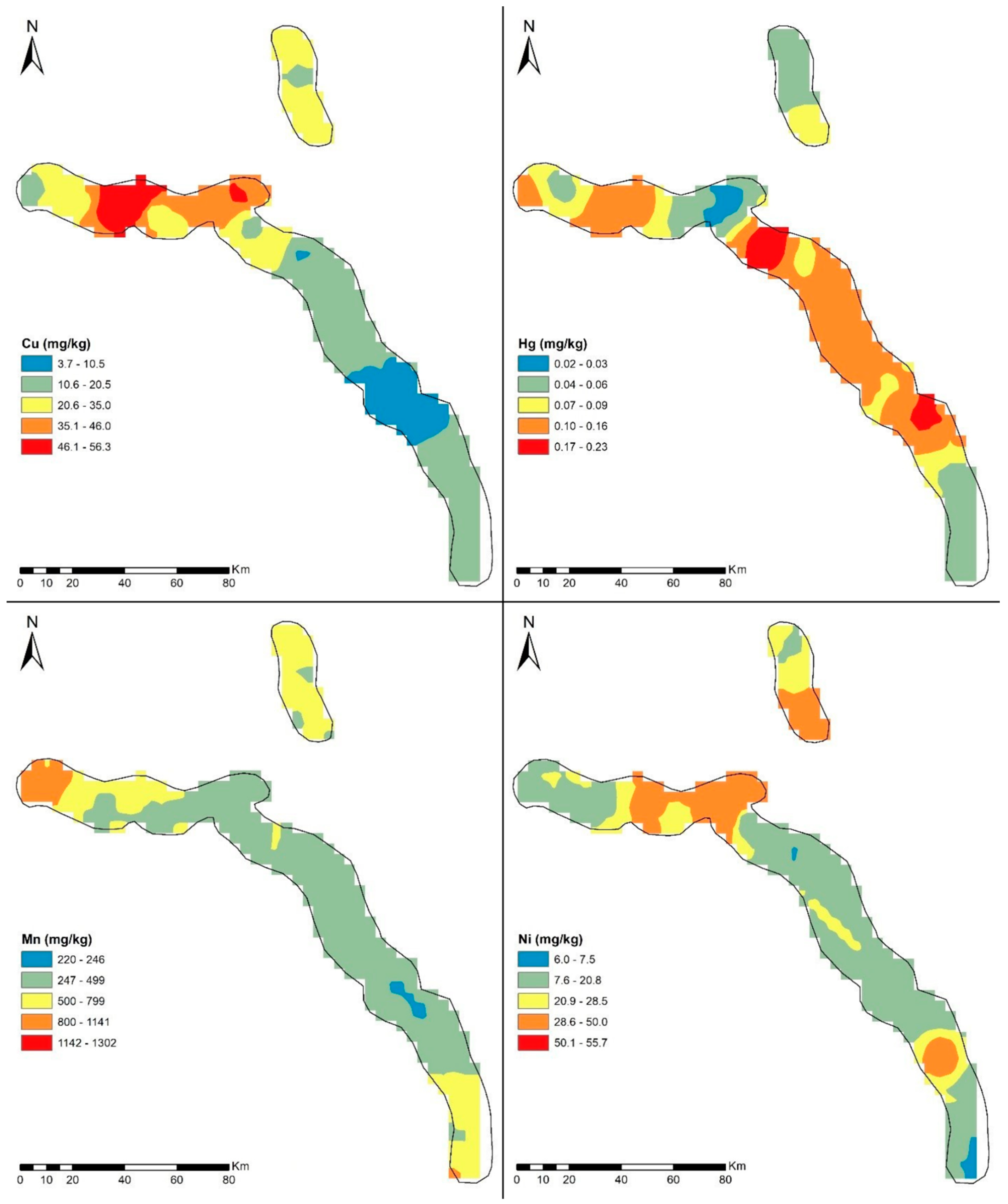
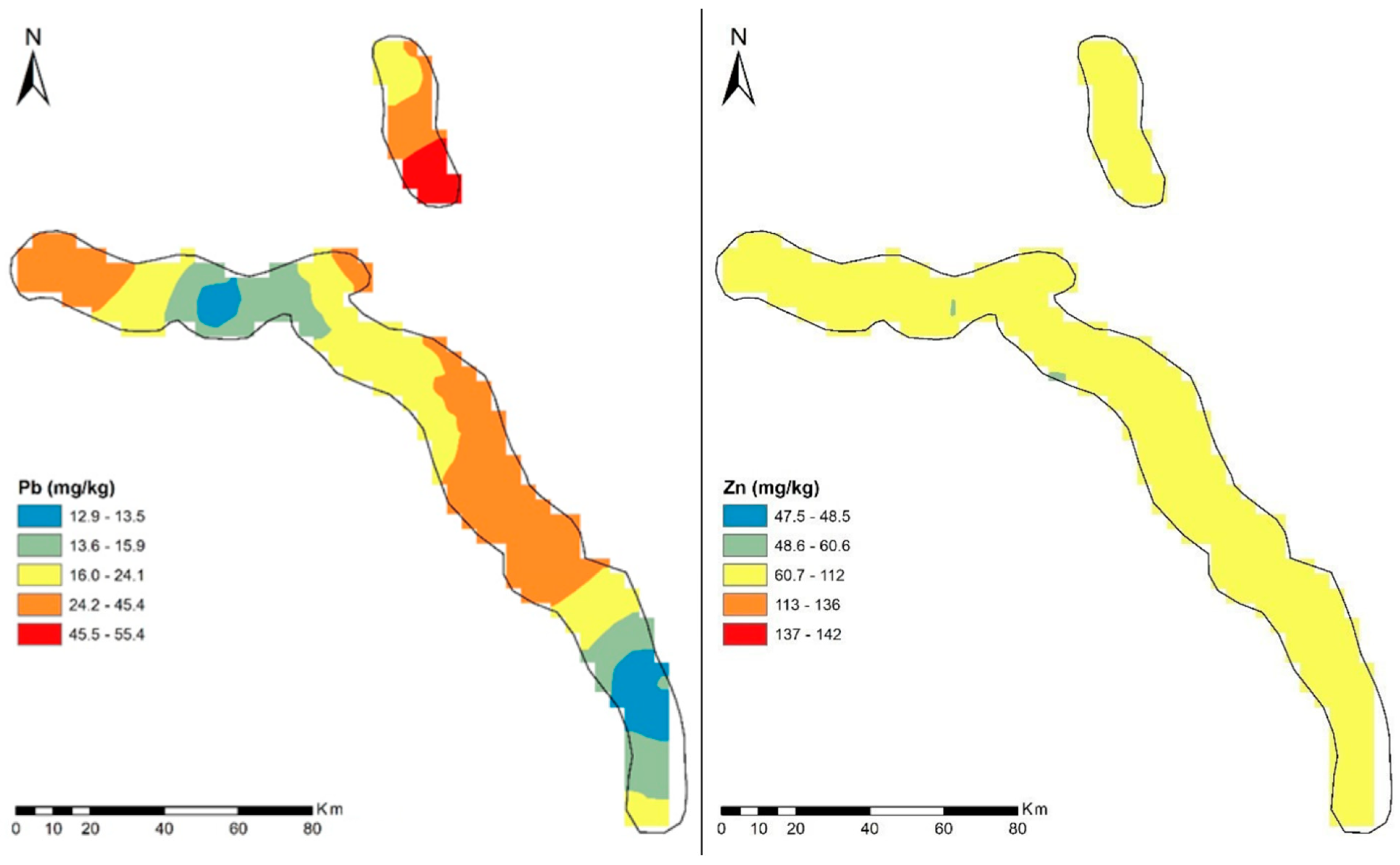
| PTE | Mean | S.D. | C.V% | Bias | Kurt. | Min | P25 | P50 | P75 | Max | MAD |
|---|---|---|---|---|---|---|---|---|---|---|---|
| Al | 20,053 | 11,301 | 56.4 | 0.82 | 0.14 | 6634 | 10,855 | 17,666 | 26,934 | 47,919 | 8534 |
| As | 11.7 | 10.7 | 91.4 | 2.9 | 13.1 | 0.25 | 6.6 | 8.7 | 14.3 | 58.1 | 3.3 |
| Ba | 67.6 | 38.7 | 57.3 | 1.3 | 3.5 | 14.2 | 35.8 | 61.4 | 86.1 | 200 | 25.7 |
| Cd | 0.31 | 0.38 | 125 | 1.9 | 4 | 0.03 | 0.08 | 0.17 | 0.4 | 1.5 | 0.12 |
| Cr | 22.5 | 25.4 | 113 | 1.3 | 1.5 | 0.04 | 4.8 | 11.3 | 36.9 | 96.9 | 11.3 |
| Cu | 25.5 | 23.4 | 91.8 | 2.1 | 7.9 | 0.74 | 10.5 | 20.5 | 35.1 | 118 | 11.2 |
| Fe | 30,301 | 19,128 | 63.1 | 1.3 | 1.9 | 5164 | 19,012 | 25,953 | 36,592 | 82,787 | 10,114 |
| Hg | 0.08 | 0.08 | 94.3 | 1.9 | 5 | 0.01 | 0.03 | 0.06 | 0.09 | 0.35 | 0.03 |
| Mn | 578 | 411 | 71.1 | 0.52 | −0.57 | 41.4 | 246 | 499 | 799 | 1446 | 258 |
| Ni | 22.3 | 17 | 76.1 | 0.66 | −0.25 | 0.97 | 7.5 | 20.8 | 28.5 | 57.7 | 10.7 |
| Pb | 23.6 | 20.7 | 87.5 | 2.9 | 12.1 | 11.8 | 13.5 | 15.9 | 24.1 | 112 | 2.9 |
| Zn | 79.2 | 45.9 | 58 | 0.81 | 0.19 | 18.7 | 48.5 | 60.6 | 112 | 204 | 30.1 |
| PTE | La Zanja | Colquirrumi | Julcani | La Pastora | Comunidad de Infierno | This Study |
|---|---|---|---|---|---|---|
| Al | - | - | - | - | - | 17,666 |
| As | 15.2 | 477 | 24.4 | 6.4 | 3.7 | 8.7 |
| Ba | - | - | - | - | - | 61.4 |
| Cd | 2.3 | 17.8 | 6 | 0.8 | <0.02 | 0.17 |
| Cr | 5.2 | 14.4 | 16.4 | - | - | 11.3 |
| Cu | 12.5 | 222 | 9.4 | 2.2 | 0.63 | 20.5 |
| Fe | - | - | - | 85 | 48.3 | 25,953 |
| Hg | 0.15 | 4 | 4.6 | - | - | 0.06 |
| Mn | - | - | - | 6.4 | 14.1 | 499 |
| Ni | 57.3 | 18.3 | 11.1 | - | - | 20.8 |
| Pb | 35 | 1296 | 238.4 | 11 | 7.2 | 15.9 |
| Zn | 44 | 2651 | 90.4 | 0.99 | 1.3 | 60.6 |
| Sample | 21 | 20 | 18 | 12 | 12 | 29 |
| Reference | [8] | [8] | [8] | [9] | [9] | This study |
| Al | As | Ba | Cd | Cr | Cu | Fe | Hg | Mn | Ni | Pb | Zn | |
|---|---|---|---|---|---|---|---|---|---|---|---|---|
| Al | 1 | −0.17 | −0.35 | −0.29 | 0.34 | −0.12 | 0.31 | 0.29 | −0.21 | 0.04 | 0.01 | −0.13 |
| As | 1 | −0.04 | 0.17 | 0.25 | 0.33 | 0.22 | 0.12 | 0.32 | 0.18 | 0.5 ** | 0.31 | |
| Ba | 1 | 0.22 | 1 × 10−3 | 0.33 | −0.07 | −0.52 ** | 0.43 * | 0.38 * | −0.17 | 0.47 * | ||
| Cd | 1 | −0.2 | −0.08 | −0.37 * | −0.07 | 0.4 * | 0.12 | 0.3 | 0.5 ** | |||
| Cr | 1 | 0.62 ** | 0.77 ** | −0.03 | 0.13 | 0.72 ** | −0.08 | 0.23 | ||||
| Cu | 1 | 0.74 ** | −0.06 | 0.44 * | 0.68 ** | 0.09 | 0.42 * | |||||
| Fe | 1 | −0.04 | 0.17 | 0.56 ** | 0.07 | 0.16 | ||||||
| Hg | 1 | −0.13 | −0.25 | 0.11 | −0.36 | |||||||
| Mn | 1 | 0.35 | 0.28 | 0.46 * | ||||||||
| Ni | 1 | −0.14 | 0.54 ** | |||||||||
| Pb | 1 | 0.37 * | ||||||||||
| Zn | 1 |
| Element | Component | |||
|---|---|---|---|---|
| 1 | 2 | 3 | 4 | |
| Al | −0.12 | 0.61 | −0.03 | 0.48 |
| As | 0.27 | −0.15 | 0.62 | −0.45 |
| Ba | 0.45 | −0.3 | −0.45 | −0.42 |
| Cd | 0.55 | −0.55 | 0.05 | 0.43 |
| Cr | 0.61 | 0.62 | −0.17 | 0.16 |
| Cu | 0.61 | 0.57 | 0.09 | −0.25 |
| Fe | 0.47 | 0.73 | 0.12 | −0.2 |
| Hg | −0.27 | 0.37 | 0.51 | 0.27 |
| Mn | 0.53 | −0.14 | 0.4 | −0.24 |
| Ni | 0.78 | 0.11 | −0.33 | 0.21 |
| Pb | 0.46 | −0.34 | 0.45 | 0.42 |
| Zn | 0.75 | −0.37 | −0.05 | 0.17 |
| Variance % | 27.4 | 20.5 | 11.5 | 10.8 |
| Cumulative Variance% | 27.4 | 47.9 | 59.4 | 70.3 |
| Al | As | Ba | Cd | Cr | Cu | Fe | Hg | Mn | Ni | Pb | Zn | |
|---|---|---|---|---|---|---|---|---|---|---|---|---|
| Median ± 2 MAD | 34,734 | 15.3 | 113 | 0.41 | 33.8 | 42.9 | 46,181 | 0.12 | 1015 | 42.2 | 21.6 | 121 |
| Outliers | 3 | 5 | 3 | 6 | 8 | 4 | 4 | 4 | 6 | 5 | 8 | 7 |
| Percentage | 10.3% | 17.2% | 10.3% | 20.7% | 27.6% | 13.8% | 13.8% | 13.8% | 20.7% | 17.2% | 27.6% | 24.1% |
| TIF | 51,053 | 25.8 | 162 | 0.9 | 85.0 | 71.8 | 62,963 | 0.18 | 1629 | 60.1 | 40.0 | 207 |
| Outliers | 2 | 1 | 3 | 1 | 1 | 3 | 3 | 4 | ||||
| Percentage | 6.9% | 3.4% | 10.3% | 3.4% | 3.4% | 10.3% | 10.3% | 13.8% | ||||
| P95 | 42,090 | 25.3 | 116 | 1.2 | 70.0 | 56.3 | 74,014 | 0.23 | 1302 | 55.7 | 55.4 | 142 |
| Outliers | 2 | 2 | 2 | 2 | 2 | 2 | 2 | 2 | 2 | 2 | 2 | 2 |
| Percentaje | 6.9% | 6.9% | 6.9% | 6.9% | 6.9% | 6.9% | 6.9% | 6.9% | 6.9% | 6.9% | 6.9% | 6.9% |
Disclaimer/Publisher’s Note: The statements, opinions and data contained in all publications are solely those of the individual author(s) and contributor(s) and not of MDPI and/or the editor(s). MDPI and/or the editor(s) disclaim responsibility for any injury to people or property resulting from any ideas, methods, instructions or products referred to in the content. |
© 2024 by the authors. Licensee MDPI, Basel, Switzerland. This article is an open access article distributed under the terms and conditions of the Creative Commons Attribution (CC BY) license (https://creativecommons.org/licenses/by/4.0/).
Share and Cite
Tume, P.; Cornejo, Ó.; Cabezas, V.; Bech, J.; Roca, N.; Ferraro, F.X.; Pedreros, J.; Sepúlveda, B. Potential Toxic Elements Pollution Status in Zones of Technogenic Impact in Central Regions of Perú. Minerals 2024, 14, 546. https://doi.org/10.3390/min14060546
Tume P, Cornejo Ó, Cabezas V, Bech J, Roca N, Ferraro FX, Pedreros J, Sepúlveda B. Potential Toxic Elements Pollution Status in Zones of Technogenic Impact in Central Regions of Perú. Minerals. 2024; 14(6):546. https://doi.org/10.3390/min14060546
Chicago/Turabian StyleTume, Pedro, Óscar Cornejo, Verónica Cabezas, Jaume Bech, Núria Roca, Francesc Xavier Ferraro, Javiera Pedreros, and Bernardo Sepúlveda. 2024. "Potential Toxic Elements Pollution Status in Zones of Technogenic Impact in Central Regions of Perú" Minerals 14, no. 6: 546. https://doi.org/10.3390/min14060546






